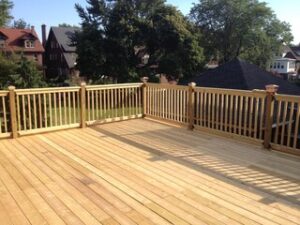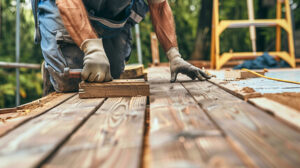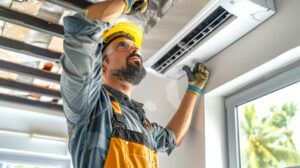Cleaning your deck is an essential outdoor maintenance task that can help keep it in top condition. Regular cleanings can reduce fading, cracking, warping, and rotting and help eliminate mold, mildew, and algae.

Start by removing all furniture, plant pots, and shoe trays from the deck. Then sweep the surface with a heavy-duty broom with durable, stiff bristles. Visit Our Website Here for more information.
Over the course of a year, organic debris such as leaves, pine straw, and acorns fall on and cling to deck surfaces. These particles become compacted and remain wet for prolonged periods of time, which leads to fungal growth such as mold and mildew. Cleaning decks regularly prevents this buildup.
Before cleaning, start by removing all furniture and plants and using a garden hose to pre-wet the surface of the deck. This loosens dirt and helps to make the cleaning process faster and more effective.
Next, sweep or use a leaf blower to remove any remaining loose dirt and debris from the deck. Then, use a putty knife or screwdriver to remove any stubborn bits stuck between the deck boards.
Once the deck is clear, apply a composite deck cleaner designed for your specific brand of decking. Follow the product instructions for proper application.
A good alternative to chemical deck cleaners is oxygen bleach. This eco-friendly solution breaks down algae, mold, and mildew. It also works well to remove grease stains from wood decks and is safe to use on stained or un-stained wood.
Once you have a cleaner on hand, use a scrub brush or deck scrubber to scrub the surface of the deck, paying special attention to areas with stains, mildew, and heavily soiled areas. After scrubbing, rinse thoroughly with a hose, being careful not to damage the surface of the deck.
Once the deck is clean, allow it to dry completely before replacing any furniture or plants. It’s also a good idea to inspect the decking for warping, discoloration, and rotted boards. If any board is rotting, replace it immediately. This prevents the rotting from spreading to the rest of the deck and causing structural issues. It is also important to replace any rusting hardware or fasteners.
Stain Removal
When you’re ready to stain your deck, it’s important to clear away the mildew, dirt and gray layer that can interfere with proper stain penetration. A professional cleaner can remove these elements to prepare the surface for a new stain and prolong its life.
If your stained deck has green algae or moss, you can get rid of these growths by using an oxygen bleach solution. This type of cleaning solution is safe for wood surfaces and doesn’t contain the harsh chemical, chlorine, that’s found in regular bleach. You can mix this product with water or purchase it in powder form and apply according to the manufacturer’s instructions.
Bleach is a great mold and mildew remover, but it can also damage wood by discoloring the surface or harming its lignin. It’s best to use a cleaning agent that doesn’t contain bleach but can still tackle stains and grime such as oil, grease and bird droppings.
Baking soda is a tried and true cleaner for all kinds of surfaces, including wood. It’s gentle enough to not damage your stain and can remove dirt, rust, mildew and other stains from fossilized dirt, bird droppings, tree sap and more. The key is to scrub the area quickly and then rinse it with a clean hose.
You can also protect your deck with a finish designed for wood, which creates a barrier to keep liquids from penetrating and creating stains. This protective coating is particularly useful for areas prone to spills and drips, such as those near barbecues or outdoor kitchens. You can even place coasters and tablecloths on these high-traffic areas to help prevent stains from forming.
Once your deck is completely dry, you can start preparing it for staining. If you’re using an oil-based stain, you’ll need to wait a few weeks after clearing the deck for it to dry thoroughly. If you’re using a water-based stain, however, it may be possible to stain it sooner.
Before staining, decide if you’ll be going with a solid or semi-transparent product and choose colors that will blend well with your existing deck. Remember that darker stains tend to show wear and weathering more quickly, so they may require reapplication sooner than lighter stains.
Pressure Washing
Regular cleaning and treatment of wood decks is an important part of keeping them looking good. While a good scrub brush and soapy water is effective on most surfaces, for some more serious stains, a professional power wash may be required. This method uses high-powered water to blast away dirt, mildew, and grime much more quickly than hand scrubbing or chemical cleaners. This method also allows for more thorough cleaning of hard-to-reach areas that are usually missed when using other methods.
To avoid damage, it is important to use a low-pressure setting and test the pressure on a small area before starting. Choosing the right setting and nozzle is also essential. A poorly-chosen setting can gouge or splinter the surface of the wood, and spraying directly at humans or pets can cause injuries. Similarly, it is important not to aim the nozzle at plants or other vegetation because the force of the water can cause damage.
The advantage of this method is that it removes most stains from the wood with very little effort and without the need for harsh chemicals, making it a safer and more environmentally friendly option than traditional cleaners. It does not, however, address deep-rooted mold or rot and may require alternative treatments.
Before beginning the cleaning process, it is important to clear the area of the deck and move all furniture or other objects. It is also a good idea to cover nearby plants with tarps or drop cloths to protect them from the cleaning solution and water. Once the deck is clean, it can be rinsed thoroughly with clean water. It is also a good idea to apply a deck brightener after the cleaning to remove any chemical residue and return the wood’s natural color.
It is recommended that you plan on cleaning your wood deck every two to three years. In addition to cleaning, regular maintenance should include periodic inspections of the deck for any signs of rot or structural damage. If you do notice any issues, they should be addressed as soon as possible to prevent the problem from getting worse.
Cleaning Without a Pressure Washer
A pressure washer can damage wood and composite decks by raising the grain of the surface and leaving divots. It can also corrode metal fasteners and screws, as well as damaging plants surrounding the deck. Instead, you can use a garden hose to spray the deck surface with a weak mixture of water and gentle cleaning product. Then, scrub the deck with a brush that has scratch-free bristles. When you finish, rinse the deck with a garden hose until it is completely clean.
Before beginning your cleaning project, clear the deck of all furniture, grills, rugs, potted plants, toys and decorations. Dragging these items across a wet deck can scar the surface and leave rust stains. It’s best to clear the entire deck in sections so that the cleaning products have enough time to work.
If you notice a sticky mess such as gum or tree sap on the deck, use a scraper or putty knife to remove it. For more stubborn stains, try a homemade cleaning solution. For instance, baking soda is safe for all surfaces and helps to remove dirt stains on stained wood. Oxygen bleach is another natural cleaning agent that can eliminate mold and mildew spores without stripping the existing stain. This cleaner can be purchased in powder form and mixed with water according to the manufacturer’s instructions.
The best part about this cleaning method is that you don’t need to purchase any specialized cleaning products. You can use products you already have in your home, such as Napisan. This household product contains sodium percarbonate, which cuts through grime and draws existing oils and saturates out of the timber grain.
You can mix Napisan with water to create a cleaning solution that’s suitable for your composite deck. You should apply this cleaner to the deck surface, and then wait for it to work for about 15 minutes. Then, use a stiff-bristled cleaning brush to scrub the deck. Scrub in the direction of the grain and continue scrubbing until the deck is clean. After you have finished, rinse the deck with a garden nozzle to ensure that all of the chemical is gone.








